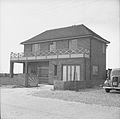Operation PLUTO
The Operation Pluto ( P IPE L ines U Direction T he O cean) was an operation by British scientists to fuel through an undersea pipeline extending from the UK by the Channel to France to transport. The plan was developed by Arthur Hartley , chief engineer of the Anglo-Iranian Oil Company (AIOC), after it was conceived by Admiral Louis Mountbatten .
The first prototypes of the pipeline were successfully tested in May 1942 through the course of the Medway and in June through the Firth of Clyde . Then production started.
The first pipeline was laid on August 12, 1944 between the Isle of Wight and Cherbourg ; it was 70 nautical miles (130 kilometers) long and 76 mm in diameter. On October 10, 1944, a pipeline was laid from Dungeness to Cherbourg (and even later through the Strait of Calais ). Tugs pulled huge drums ( called conundrum ), each of which could hold up to 80 nautical miles of pipe, across the canal and unwound multi-layer pipelines over a length of 67 nautical miles, after which they were connected to each other and laid on the seabed. The operation was carefully prepared and completed within ten hours.
The output of the pipeline in January 1945 was about 300 tons of fuel per day; it then grew to more than 1.35 million gallons (about 6.14 million liters) per day at peak times . A total of 651 million liters of fuel had been pumped through the pipeline by the day of the German surrender. Alongside the Mulberry ports , PLUTO is considered to be one of the greatest military engineering achievements in history.
With the pipelines, the Allies avoided losing tankers to German attacks (e.g. by submarines ) in the English Channel.
See also
Web links
- Detailed information (English)
- Picture page from the Chronicle of the Naval War 1939–1945
- Photo (English)
- Universal Newsreel from June 4, 1945 with a report on Operation PLUTO for download from archive.org





